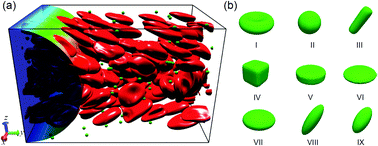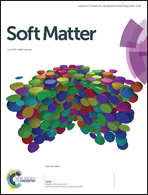Shear rate dependent margination of sphere-like, oblate-like and prolate-like micro-particles within blood flow†
Abstract
This study investigates the shear rate dependent margination of micro-particles (MPs) with different shapes in blood flow through numerical simulations. We develop a multiscale computational model to handle the fluid–structure interactions involved in the blood flow simulations. The lattice Boltzmann method (LBM) is used to solve the plasma dynamics and a coarse-grained model is employed to capture the dynamics of red blood cells (RBCs) and MPs. These two solvers are coupled together by the immersed boundary method (IBM). The shear rate dependent margination of sphere MPs is firstly investigated. We find that margination of sphere MPs dramatically increases with the increment of wall shear rate ![[small gamma, Greek, dot above]](https://www.rsc.org/images/entities/i_char_e0a2.gif) ω under 800 s−1, induced by the breaking of rouleaux in blood flow. However, the margination probability only slowly grows when
ω under 800 s−1, induced by the breaking of rouleaux in blood flow. However, the margination probability only slowly grows when ![[small gamma, Greek, dot above]](https://www.rsc.org/images/entities/i_char_e0a2.gif) ω > 800 s−1. Furthermore, the shape effect of MPs is examined by comparing the margination behaviors of sphere-like, oblate-like and prolate-like MPs under different wall shear rates. We find that the margination of MPs is governed by the interplay of two factors: hydrodynamic collisions with RBCs including the collision frequency and collision displacement of MPs, and near wall dynamics. MPs that demonstrate poor performance in one process such as collision frequency may stand out in the other process like near wall dynamics. Specifically, the ellipsoidal MPs (oblate and prolate) with small aspect ratio (AR) outperform those with large AR regardless of the wall shear rate, due to their better performance in both the collision with RBCs and near wall dynamics. Additionally, we find there exists a transition shear rate region 700 s−1 <
ω > 800 s−1. Furthermore, the shape effect of MPs is examined by comparing the margination behaviors of sphere-like, oblate-like and prolate-like MPs under different wall shear rates. We find that the margination of MPs is governed by the interplay of two factors: hydrodynamic collisions with RBCs including the collision frequency and collision displacement of MPs, and near wall dynamics. MPs that demonstrate poor performance in one process such as collision frequency may stand out in the other process like near wall dynamics. Specifically, the ellipsoidal MPs (oblate and prolate) with small aspect ratio (AR) outperform those with large AR regardless of the wall shear rate, due to their better performance in both the collision with RBCs and near wall dynamics. Additionally, we find there exists a transition shear rate region 700 s−1 < ![[small gamma, Greek, dot above]](https://www.rsc.org/images/entities/i_char_e0a2.gif) ω < 900 s−1 for all of these MPs: the margination probability dramatically increases with the shear rate below this region and slowly grows above this region, similar to sphere MPs. We further use the surface area to volume ratio (SVR) to distinguish different shaped MPs and illustrate their shear rate dependent margination in a contour in the shear rate–SVR plane. It is of significance that we can approximately predict the margination of MPs with a specific SVR. All these simulation results can be potentially applied to guide the design of micro-drug carriers for biomedical applications.
ω < 900 s−1 for all of these MPs: the margination probability dramatically increases with the shear rate below this region and slowly grows above this region, similar to sphere MPs. We further use the surface area to volume ratio (SVR) to distinguish different shaped MPs and illustrate their shear rate dependent margination in a contour in the shear rate–SVR plane. It is of significance that we can approximately predict the margination of MPs with a specific SVR. All these simulation results can be potentially applied to guide the design of micro-drug carriers for biomedical applications.



 Please wait while we load your content...
Please wait while we load your content...